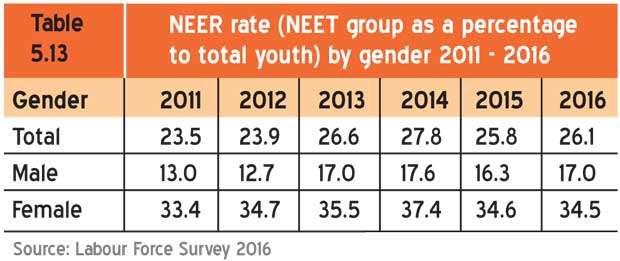Reply To:
Name - Reply Comment

 In the local and global labour market, those involved in mass production in particular, the trend is towards creating a large number of low skill employment. Low skill jobs have a very narrow range of skills that need no training or training of few days if not a few hours.
In the local and global labour market, those involved in mass production in particular, the trend is towards creating a large number of low skill employment. Low skill jobs have a very narrow range of skills that need no training or training of few days if not a few hours.
In Sri Lanka, a large number of low skilled jobs are available in the service sector such as shopping malls and supermarkets as well as in industries with mass-scale production lines, such as the factories in the free trade zones.
Many school leavers, who are not selected for higher education, are attracted to these unskilled or low skilled jobs in shops and industries. These youngsters who embark on these jobs without any formal training stick with the job for only a short period of time.
Although one can always see young sales persons in shopping malls and supermarkets, we do not see the same person over a long period of time because after some time they tend to leave the jobs.
In mass-scale production lines in free trade zone factories, a large number of youth are employed in unskilled jobs. Their job role could be one such as picking up a semiconductor from a moving belt for a visual check to be placed in the accepted or rejected box or it could even be repetitively fastening of a transistor to a circuit board on the moving belt.
The young workers do not stay in this type of employment for long, usually for a maximum period of around five years. The high labour turnover in free trade zone industries has become a very serious issue.
According to the labour force survey 2016, published by the Census and Statistics Department, the labour force participation of 15 to 19 years age group is 13.8 percent and 73 percent of them are employed. (Labour force participation means people employed or seeking employment). Considering this age range, a majority of them would have obtained jobs without any formal training. Therefore, they should invariably fall into the low skilled jobs category.

The labour force survey has identified yet another youth group who are ‘Not in Employment, Education and Training’, termed as the NEET group. According to the 2016 labour force survey, 26.1 percent of youth (15 to 29 age group) fall into this NEET category. This data has been provided by Census and Statistics the Department.
It becomes necessary to look critically into the context of this data. It is a fact that no person could exist up to 29 years without any job or an income. Therefore, it can be safely assumed that these youth engage in irregular work which would mean that they are on and off employment from time to time.
These are not continuous jobs but at any given point of time, approximately 26.1 percent are unemployed. The irregular jobs are also low skilled jobs. When 26.1 percent of the NEET group and young employees in low skilled employment are taken into account, more than 30 percent of youth are engaged in low skilled jobs.
The monthly income from these unskilled jobs range from Rs.25,000 to Rs.35,000. At the time of leaving school, this salary may look attractive but as adults and particularly after marriage, these earnings become insufficient. The majority of those engaged in low skilled jobs leave due to no increase in their earnings as well as no promotional prospects.
Further, repetitive and monotonous nature of the work does not appeal to youth to stay in these jobs over a long period of time. The narrow range of skills acquired in these low skilled jobs is not sufficient to find alternative employment.
The women who leave these low skilled jobs may not look for work and remain unemployed and join the 64.1 percent economically inactive females. (Females labour force participation is 35.9 percent and therefore, 64.1 percent are economically inactive).
The men who leave low skilled jobs find numerous jobs in informal sector. As a result, the majority of youth in these low skilled jobs become stranded in the labour market without decent employments. That is the reason why these low skills jobs are known as the ‘skill trap’. I became aware of the concept of the ‘low skill trap’ at an international skill forum.
In Sri Lanka, more than 60 percent of the labour force is in informal employment. This rate has remained almost unchanged during the last two decades as well. But, it is a fact that a large number of formal businesses and industries have been established during this period.
Then, how is it that this percentage of informal jobs did not reduce? This is mainly because those new businesses and industries have created formal but low skilled jobs and those job holders eventually end up with informal jobs.
When the percentage of skilled jobs in formal businesses and industries increase, factually the percentage of informal jobs should reduce. When the percentage of informal jobs does not reduce, there will be skill shortages to meet the increasing demand for skilled jobs in formal businesses and industries.
The current employment structure therefore attracts a large number of youth to low skilled jobs in formal businesses and industries which eventually lead them to low skilled jobs in the informal sector. This scenario creates skill shortages in the formal businesses and industries.
Low skilled jobs are required by the industry and youth also need these jobs immediately after leaving schools to face poverty. Therefore, these low skilled jobs cannot be stopped. But youth should be assisted to come out of the low skilled trap while being in the low skilled jobs.
That means youth should be given opportunities to acquire skills for higher skilled jobs whilst in employment in low skilled jobs. This is a significant number; 30 percent of an age cohort.
Both vocational training institutions as well as employers have the responsibility to stop youth in low skilled jobs fall in to the informal sector which eventually create skill shortages in the formal sector. Therefore, vocational training institutions should expand their training programmes to provide part time training facilities and employers should encourage employees in low skilled jobs to follow skills upgrading courses.
Other negative effects of low skilled jobs and expanding informal sector will be discussed in a separate article.
(B.H.S. Suraweera, former Deputy Director General (retired) of the Tertiary and Vocational Education Commission, can be reached at [email protected])